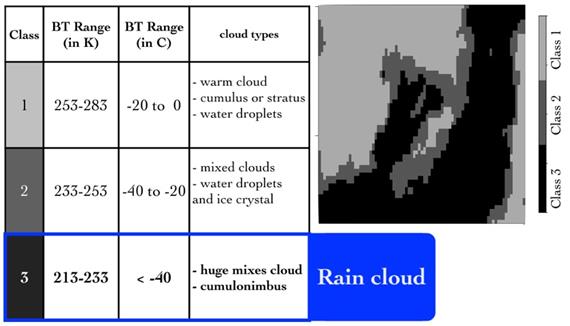An analysis of cloud distribution to rainfall occurrence for future forecast improvement affecting urban living
Main Article Content
บทคัดย่อ
Meteorological Remote Sensing data contain a vast amount of weather information. It is a valuable source of information in weather forecasting and early prediction of different atmospheric disturbances. Cloud conditions play an important role in many types of research such as weather and climate-related which can be utilized from the weather satellite data. In this research, Multi-functional Transport Satellite (MTSAT) meteorological satellite images are used for automatic extraction of cloud-top temperature feature for estimation rainfall occurrence which can be useful for urban living. The weather, especially the rainfall occurrence, has been found to have a significant impact on some phenomena related to human behavior in urban living. The gray level co-occurrence matrix (GLCM) algorithm is applied for measuring of cloud texture. Euclidean distance analysis was used to compare the similarity condition among rainfall occurrences. The relationship between rainfall distribution and the associated cloud properties using satellite image are evaluated for future forecast improvement in this study. The precision experiment yields 87.5% which can imply that the analysis is significantly improving if there is a sufficient spatial and temporal distribution of data exists.
Article Details

อนุญาตภายใต้เงื่อนไข Creative Commons Attribution-NonCommercial-NoDerivatives 4.0 International License.
เอกสารอ้างอิง
Chonmapat Torasa (2009). Near-Real time rainfall estimation using APT data from NOAA satellites and meteorological data. School of Remote Sensing Institute of Science Suranaree University of Technology.
Digata Kumar Sarma, Mahen Konwar, and Sanjay Sharma (2006). "Characteristic of brightness temperature with respect to rain rate over ocean land and its implication on rain rate retrieval", (September 2006) Indian Journal of Radio and Space Physics 35(4): 259-269.
Japan Meteorological Agency. (2009). Monitoring the earth from the MTSAT [Online]. Available: http://mscweb.kishou.go.jp/index.htm
Dioszeghy, M. and Fejes, E. (1995). "Cloud classification derived from Meteosat data involving the standard deviation fields of the brightness values", Advances in Space Research Vol. 16, Issue 10, 1995, pp 33-36.
Massons, J., Domingo, D. and Grau, J. (1996). "Automatic Classification of VIS-IR Meteosat images", Journal of Computers & Geosciences. 22(10): 1137-1146.
Inoue, T. (1985). "On the temperature and effective emissivity determination of semitransparent cirrus clouds by bispectral measurements in the 10 μm window region", Journal of Meteorology Society Japan. 63: 88-98.
Hayasaka, T. (1996). "Recent studies on satellite remote sensing of clouds in Japan. Advances in Space Research", Vol. 18, Issue 7, 1996, pp 29-36.
Cooper, S., Ecuyer, T.L. and Stephens, G. (2003). "The Impact of Explicit Cloud Boundary Information on Ice Cloud Microphysical Property Retrievals from Infrared Radiances", Journal of Geophysical Research, Vol. 108, No. D3, 4107, doi:10.1029/2002JD002611, 2003, 1-17.
R. Gonzalez (2009). Digital image processing. Dorling Kindersley: Pearson Prentice Hall.
R. Holowczak, F. Artigas, Soon Ae Chun, June-Suh Cho, and H. Stone (2002). "An experimental study on content-based image classification for satellite image databases", IEEE Transactions on Geoscience and Remote Sensing (Volume: 40, Issue: 6, Jun 2002), pp 1338-1347.
Pornthip Bumrungklang (2008). An analysis of seasonal thunderstorm cloud distribution and its relation to rainfall occurrence in Thailand using remotely-sensed data. School of Remote Sensing Institute of Science Suranaree University of Technology.
American Meteorology Society. (2009). Glossary of Meteorology [On-line]. Available: http://amsglossary.allenpress.com/glossary
National Aeronautics and Space Administration-Cloud and Radiation (2009). The Earth’s Climate System Constantly Adjusts [On-line]. Available: http://earthobservatory.nasa.gov/Features/Clouds.
Dioszeghy, M. and Fejes, E. (1995). "Cloud classification derived from Meteosat data involving the standard deviation fields of the brightness values", Advances in Space Research Vol. 16, Issue 10, 1995, pp 33-36.
Tsonis, A.A. and Isaac, G.A. (1985). "On a new approach for instantaneous rain are delineation in the midlatitudes using GOES data", Journal of Applied Meteorology and Climatology, Vol. 24: Issue 11, pp 1208–1218.


